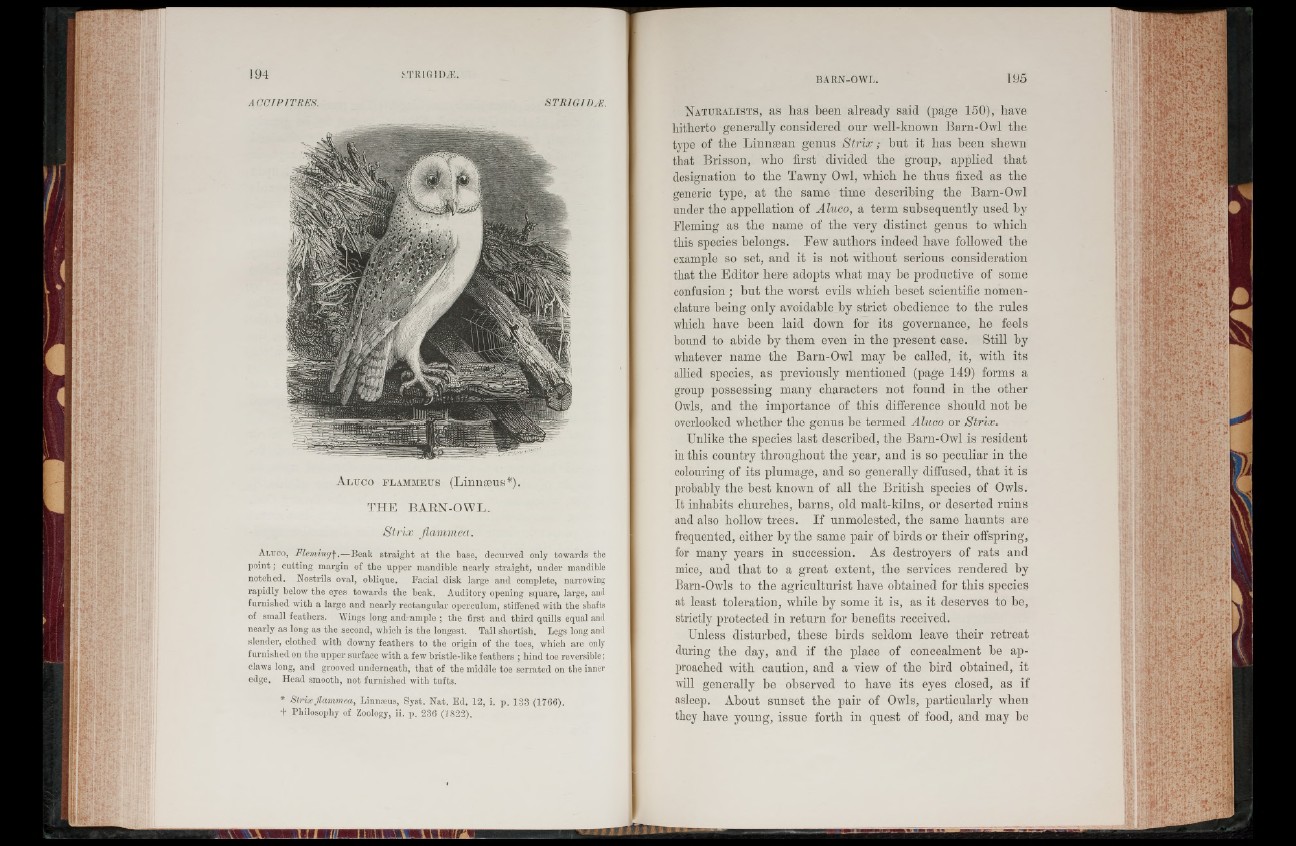
Strix flammea.
A l u c o , Flemingf.—Beak straight at the base, decurved only towards the
point; cutting margin of the upper mandible nearly straight, under mandible
notched. Nostrils oval, oblique. Facial disk large and complete, narrowing
rapidly below the eyes towards the beak. Auditory opening square, large, and
furnished with a large and nearly rectangular operculum, stiffened with the shafts
of small feathers. Wings long and ample ; the first and third quills equal and
nearly as long as the second, which is the longest. Tail shortish. Legs long and
slender, clothed with downy feathers to the origin of the toes, which are only
furnished on the upper surface with a few bristle-like feathers ; hind toe reversible;
claws long, and grooved underneath, that of the middle toe serrated on the inner
edge. Head smooth, not furnished with tufts.
* Strix flammeat Linnaeus, Syst. Nat. Ed. 12, i. p. 133 (1766).
+ Philosophy of Zoology, ii. p. 236 (i 822).
. \ A ll .ill . M T ' i
N a t u r a l is t s , as lias been already said (page 150), have
hitherto generally considered our well-known Barn-Owl the
type of the Linnsean genus S tr i x ; but it has been shewn
that Brisson, who first divided the group, applied that
designation to the Tawny Owl, which he thus fixed as the
generic type, at the same time describing the Barn-Owl
under the appellation of Aluco, a term subsequently used by
Fleming as the name of the very distinct genus to which
this species belongs. Few authors indeed have followed the
example so set, and it is not without serious consideration
that the Editor here adopts what may be productive of some
confusion ; but the worst evils which beset scientific nomenclature
being only avoidable by strict obedience to the rules
which have been laid down for its governance, he feels
bound to abide by them even in the present case. Still by
whatever name the Barn-Owl may be called, it, with its
allied species, as previously mentioned (page 149) forms a
group possessing many characters not found in the other
Owls, and the importance of this difference should not be
overlooked whether the genus be termed Aluco or Strix.
Unlike the species last described, the Barn-Owl is resident
in this country throughout the year, and is so peculiar in the
colouring of its plumage, and so generally diffused, that it is
probably the best known of all the British species of Owls.
It inhabits churches, barns, old malt-kilns, or deserted ruins
and also hollow trees. If unmolested, the same haunts are
frequented, either by the same pair of birds or their offspring,
for many years in succession. As destroyers of rats and
mice, and that to a great extent, the services rendered by
Barn-Owls to the agriculturist have obtained for this species
at least toleration, while by some it is, as it deserves to be,
strictly protected in return for benefits received.
Unless disturbed, these birds seldom leave their retreat
during the day, and if the place of concealment be approached
with caution, and a view of the bird obtained, it
will generally be observed to have its eyes closed, as if
asleep. About sunset the pair of Owls, particularly when
they have young, issue forth in quest of food, and may be